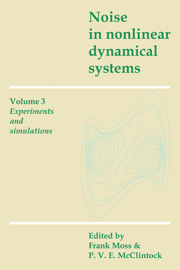Book contents
- Frontmatter
- Contents
- List of contributors
- Preface
- Introduction to Volume 3
- 1 The effects of colored quadratic noise on a turbulent transition in liquid He II
- 2 Electrohydrodynamic instability of nematic liquid crystals: growth process and influence of noise
- 3 Suppression of electrohydrodynamic instabilities by external noise
- 4 Colored noise in dye laser fluctuations
- 5 Noisy dynamics in optically bistable systems
- 6 Use of an electronic model as a guideline in experiments on transient optical bistability
- 7 Computer experiments in non-linear stochastic physics
- 8 Analogue simulations of stochastic processes by means of minimum component electronic devices
- 9 Analogue techniques for the study of problems in stochastic nonlinear dynamics
- Index
2 - Electrohydrodynamic instability of nematic liquid crystals: growth process and influence of noise
Published online by Cambridge University Press: 05 January 2012
- Frontmatter
- Contents
- List of contributors
- Preface
- Introduction to Volume 3
- 1 The effects of colored quadratic noise on a turbulent transition in liquid He II
- 2 Electrohydrodynamic instability of nematic liquid crystals: growth process and influence of noise
- 3 Suppression of electrohydrodynamic instabilities by external noise
- 4 Colored noise in dye laser fluctuations
- 5 Noisy dynamics in optically bistable systems
- 6 Use of an electronic model as a guideline in experiments on transient optical bistability
- 7 Computer experiments in non-linear stochastic physics
- 8 Analogue simulations of stochastic processes by means of minimum component electronic devices
- 9 Analogue techniques for the study of problems in stochastic nonlinear dynamics
- Index
Summary
Introduction
The electrohydrodynamic (EHD) instability in nematic liquid crystals (NLCs) has received considerable attention in recent years for two main reasons. The first is that it enables one to study the formation process of a dissipative structure including the onset of chaos (Hirakawa and Kai, 1977; Kai, Araoka, Yamazaki and Hirakawa, 1979a; Kai and Hirakawa, 1977,1978; Kai, Wakabayashi and Imasaki, 1986). The second is that it allows experimental access to a multiplicative stochastic process (Schenzle and Brand, 1979) because it is easy to obtain a fluctuating control parameter, the so-called multiplicative noise (Kai, Kai, Takata and Hirakawa, 1979b; Kawakubo, Yanagita and Kabashima, 1981). These two aspects of the EHD instability involve a wide range of interesting new phenomena that need to be accounted for. The onset of dissipative structures (pattern formations) can be observed corresponding to instabilities relaxing from unstable to stable states of thermodynamically excited systems. The dynamical phenomena near such instability points have been studied in various fields, such as hydrodynamic instabilities (Croquette and Pocheau, 1984; Greenside and Coughran, 1984; Greenside and Cross, 1985; Pocheau and Croquette, 1984; Pomeau and Zaleski, 1983; Tesauro and Cross, 1986); phase separations (Furukawa, 1985; Gunton, San Miguel and Sohni, 1983; Komura, Osamura, Fujii and Takeda, 1984); oscillatory instabilities in electrical circuits (Kabashima, Itsumi, Kawakubo and Nagashima, 1975); and in laser radiation (Arecchi and Degiorgio, 1971).
- Type
- Chapter
- Information
- Noise in Nonlinear Dynamical Systems , pp. 22 - 76Publisher: Cambridge University PressPrint publication year: 1989
- 4
- Cited by



